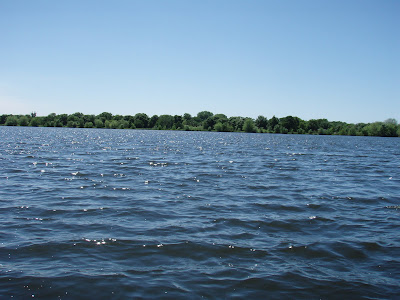Believe it or not, there's a lot connected to the art of rowing. After all it's been around since there were boats. More recently it's become an Olympic event. This is one of those things which looks really easy when you see it done on TV. In truth, it takes time and lots of practice to get good at it. So, just for laughs, I thought I would post some of the terms in common usage.
I admit I'm pretty much of a newbie, but I'm not going to let that stop me! Just going over the terms makes me more aware of what I'm doing out on the water, and of course, it improves my own technique.
General Terms
Hatchets: Also known as "big blades," or "cleavers," or "choppers," this is a relatively new blade design used for competitive rowing especially now in the Olympics.
Scull: A general term which can refer to the boat, the oars, or the rowing art itself. "scull" is used for mostly for the sport. The rest of us just "row."
Shell: A long, narrow racing boat with a shallow draft and a minimum of windage, usually made from carbon fiber or some other exotic material. Shells look great. I keep thinking about owning one, except they are really only designed to move in a straight line at the highest possible speed.
Button: a ring around the oar shaft which is designed to hold the oar in place in the oarlock.
button and oar sleeve
Pitch: the angle between an oar and the water.
Gunwale, saxboard, or gunnel: the top rail along the sides of a boat where the oarlocks are often mounted.
gunwale
Keel: the structural backbone of a boat running along the bottom of the hull on the centerline. These days many boats do not have a keel.
keel
Skeg: boats which do not have keels usually have a shortened board on the outside of the hull toward the stern. The skeg works a little like the tail of an airplane, stabilizing the direction of movement.
Terms for the Rowing Cycle
Release: a sharp, downward hand motion which lifts the oar out of the water at the end of the rowing cycle.
Feathering: the act of turning the oar blade horizontal as the oar leaves the water. Feathering is meant to reduce air resistance in racing, but also useful for anyone rowing on windy days.
Squaring: the process of returning the oar blades to a perpendicular position just before entering the water.
Catch: the process of putting the oars into the water so that the blades can dig in.
Drive: this is the portion of the rowing cycle when the oar blade is immersed in the water and the boat is propelled forward. The drive begins with a lot of leg power and usually ends with the back doing most of the pulling.
Finish: the last part of the drive when the back and the arms complete the rowing motion,
Layback: the very last part of the cycle where the rower leans as far backward as possible.
Ratio: the ratio of the drive time to the recover time. The recover time should be longer than the drive time.
Rating: the number of strokes per minute.
Crab: a problem encountered by the rower usually at the catch or release part of the cycle.
Missing water, or also "rowing into the catch:" a problem which occurs when the rower does not catch water before the drive cycle begins.
Washing out: a fault which happens when the oars leave the water before the drive is completed.
Layback: the very last part of the cycle where the rower leans as far backward as possible.
Ratio: the ratio of the drive time to the recover time. The recover time should be longer than the drive time.
Rating: the number of strokes per minute.
Crab: a problem encountered by the rower usually at the catch or release part of the cycle.
Missing water, or also "rowing into the catch:" a problem which occurs when the rower does not catch water before the drive cycle begins.
Washing out: a fault which happens when the oars leave the water before the drive is completed.
















